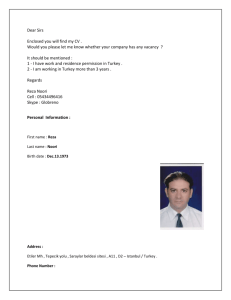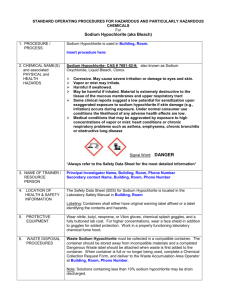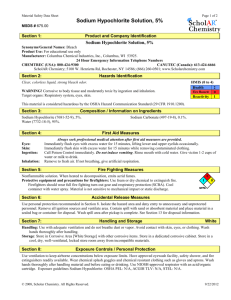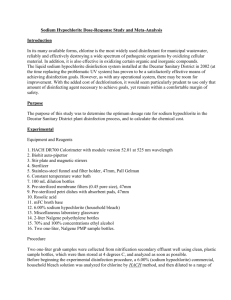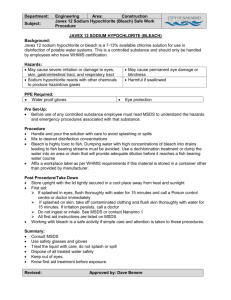Sodium Hypochlorite
advertisement
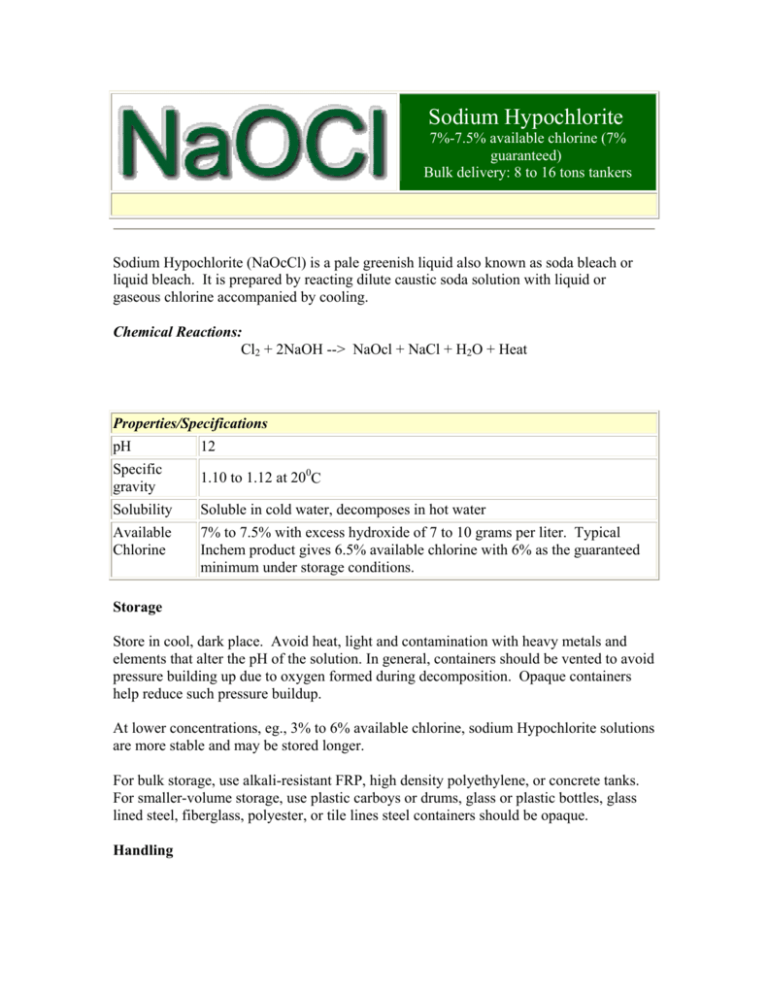
Sodium Hypochlorite 7%-7.5% available chlorine (7% guaranteed) Bulk delivery: 8 to 16 tons tankers Product Information Sodium Hypochlorite (NaOcCl) is a pale greenish liquid also known as soda bleach or liquid bleach. It is prepared by reacting dilute caustic soda solution with liquid or gaseous chlorine accompanied by cooling. Chemical Reactions: Cl2 + 2NaOH --> NaOcl + NaCl + H2O + Heat Properties/Specifications pH 12 Specific gravity 1.10 to 1.12 at 200C Solubility Soluble in cold water, decomposes in hot water Available Chlorine 7% to 7.5% with excess hydroxide of 7 to 10 grams per liter. Typical Inchem product gives 6.5% available chlorine with 6% as the guaranteed minimum under storage conditions. Storage Store in cool, dark place. Avoid heat, light and contamination with heavy metals and elements that alter the pH of the solution. In general, containers should be vented to avoid pressure building up due to oxygen formed during decomposition. Opaque containers help reduce such pressure buildup. At lower concentrations, eg., 3% to 6% available chlorine, sodium Hypochlorite solutions are more stable and may be stored longer. For bulk storage, use alkali-resistant FRP, high density polyethylene, or concrete tanks. For smaller-volume storage, use plastic carboys or drums, glass or plastic bottles, glass lined steel, fiberglass, polyester, or tile lines steel containers should be opaque. Handling Strong sodium Hypochlorite solutions are powerful oxidizing agents that rapidly produce burns when in contact with the skin. Do not handle directly or allow the solution to splash or spill on any part of the body. Avoid accidental mixing with acids, as this will liberate chlorine gas. With ammonia or ammonium compounds, explosive products may be formed. Certain organic compounds like acetone and formaldehyde react vigorously with sodium Hypochlorite solutions. Similarly organic contamination of any kind is liable to cause decomposition, which is especially dangerous with strong Hypochlorite solutions. Uses of Sodium Hypochlorite Common Uses Bleaching Oxidation Disinfection Coagulation Odor Control Precipitation Chlorination of drinking and process water Septication Elimination of slime and algae in swimming pool and boiler water pH Adjustment Dehairing (in leather industries) User Industries/Establishments Poultries Bottling Piggeries Wood Processing Dairies Laundries Food Processors Hospitals Petroleum Refineries Hotels/Motels Oil Refineries Households Textile industry Waste and sewage treatment Pulp and Paper Industry Boiler maintenance services Soap Manufacturing Typical Applications Chlorination of Drinking water To obtain a chlorine level of 0.5 ppm for potable water supply, sodium Hypochlorite (6% available chlorine solution) may be proportioned as follows: cu. m of water x 40 = cc of NaOCl needed thus, 1 cu m H2O requires 40 cc of NaOCl to get 0.5 ppm FOR LARGE QUANTITIES Mix 40 cc of NaOCl per cu.m of water (equivalent to about 8 teaspoonfuls per cu.m of water) or mix 8 cc of NaOCl per 200 liter drum of water (equivalent to about 1-1/2 teaspoonful per drum of water. FOR SMALL QUANTITIES Step 1. Mix 1 part by volume of NaOCL to 5 parts of water. This will provide a dilute 1% solution. Step 2. Add 5cc (1 teaspoonful) of the dilute 1% solution to every 5gallon of water. For large or small quantities, let the newly chlorinated water stand for 20 to 30 minutes before drinking. Chlorination of Swimming Pool Use 40cc of 6% Sodium Hypochlorite per cubic meter of water. One liter of Sodium Hypochlorite will disinfect 25 cu.m of swimming pool water. To apply, dilute the sodium Hypochlorite by mixing one part by volume of the chemical to 5 parts of water, then inject the dilute solution through the pump or sprinkle manually around the pool. Drinking Water for Poultry/Livestock Drinking water of poultry and pigs should be chlorinated to prevent water-borne diseases. Use the same proportions as those indicated under "Chlorination of Drinking Water", above; viz., 40cc per cu.m of water. Sanitation Animal pens Wastes and garbage Floors of Food processing Plants Toilets and Bathrooms Equipment and instruments Instrument rooms Poultry houses Step 1. Prepare a 60 ppm solution using any of the following proportions: 1cc of 6% NaOCL for every liter of water or 2 teaspoonful (10cc) of NaOCL for every 10 liters of water or 4 teaspoonful (20cc) of NaOCL for a 5 gallon canful of water. Step 2. Spray the solution on the items, walls, floors, wastes or garbage to be disinfected. Allow about 2 minutes of contact time for the solution to sanitize completely. Small instruments may be disinfected by immersing in the solution. To neutralize strong odors, as in garbage, double the concentration of the spray solution. Warning: The solution is capable of bleaching colored fabrics and paints. Bleaching of Cloth (Household and Laundry) Step 1. prepare a 30ppm solution by adding 2 teaspoonful of 6% Hypochlorite for every 5 gallon Step 2. Soak the cloth for about 15 minutes. Control of Bacteria and Slime in Industrial Water Sodium Hypochlorite can be used to control bacteria and slime in process water for beverages, canning and other food processing industries. The addition of 40cc to 80cc of 6% sodium Hypochlorite per cubic meter of water controls slimes, tubercules and larva stages of larger organisms. Aside from bacterial and slime control, the chlorine in the sodium Hypochlorite also oxidizes the iron and manganese in the water and destroys sulfur dioxide and ammonia. Usually, the amount of Hypochlorite needed for industrial waters is determined by analysis, to establish that level so that after contact of about 20 minutes there is residual chlorine of 0.5 to 2.0ppm I. CHEMICAL IDENTIFICATION Trade Name Chemical Name Chemical formula Concentration in water solution CAS No. - Liquid Bleach, Soda Bleach - Sodium hypochlorite - NaOCl - - 5 to 7% Available chlorine 7681-52-9 II. PHYSICAL CHARACTERISTICS Boiling Point - 1200 C Freezing Point - 8.60 C Specific gravity - 1.11 - 1.2 @ 250 C Appearance - Clear pale yellow solution with Chlorine odor. III. REGULATORY INFORMATION TSCA - CAS No. : 7681-52-9 ID No. : NA-1791 (RO) DOT Hazard class : Corrosive Material Sodium hypochlorite is an oxidizing agent. IV. PHYSICAL HAZARDS Flash point Flammable limits in air Extinguishant Oxidant Corrosive solution : NA : Non combustible : Water V. HEALTH HAZARD Sodium hypochlorite contains chlorine. Inhalation of fumes is to be avoided as it may cause respiratory irritation. Strong sodium hypochlorite solutions are powerful oxidizing agents that slowly produce burns when in contact with the skin. Inhalation may cause burns on mouth, throat and stomach. VI. EMERGENCY FIRST AID EYE CONTACT - Immediately flush eyes with directed stream of water for at least 15 minutes while forcibly holding eyelids apart to insure complete irrigation of all eye and lid tissue. SKIN CONTACT - Flush exposed areas with plenty of water for at least 15 mins. INHALATION - Removed to fresh air and have the victim drink milk, milk of magnesia or small amount of brandy. INGESTION - If swallowed and victim is conscious, have victim drink water, brandy or milk. Do not give vinegar or fruit juices because they are acidic. Do not induce vomiting. If swallowed and victim is unconscious or having convulsions, keep victim warm and get medical help immediately. VII. PROTECTIVE EQUIPMENT VENTILATION - Storage and working area should be well ventilated. Local exhausts are necessary to suck any fumes. CLOTHING - Appropriate clothing to prevent the solutions contact with skin. EYE PROTECTION - Normally no fumes but to avoid contacts with eyes, wear goggles and face shield when handling. HAND PROTECTION - Rubber gloves must be used to avoid skin contact. VIII. SPILLS, LEAKS AND DISPOSAL PROCEDURES SPILLS - flush with water to dilute the solution. Neutralize with Sodium Sulfide, Sodium Sulfite, or Sodium thiosulfate solution. LEAKS - should be repaired immediately. Leaks in tanks, pipe valves, etc. should be flush with large quantity of water to dilute the solution. DISPOSAL - dilute sodium hypochlorite should be flushed out with plenty of water to reduce available chlorine content to less than 20 ppm level. If necessary neutralize with solution of sodium sulfite, sodium sulfide or sodium thiosulfate. IX. SPECIAL PRECAUTIONS AND ADDITIONAL INFORMATION 1. Sodium hypochlorite is a strong oxidizing agent. Do not mix with reducing agents such as rags, wood fibers, paper debris, etc. or with reducing chemicals except under controlled conditions. Do not discord concentrated sodium hypochlorite indiscriminately. A spontaneous combustion fire could result. 2. Do not mix acids, ammonia or any ammoniated chemicals (such as amines). Chlorine which is hazardous gas will be released. 3. Store in corrosion resistant tanks such as hard rubber lined steel tanks, PVC, Polyethylene, FRP and other plastic tanks. Heavy metal pick-up in sodium hypochlorite solution will decompose the sodium hypochlorite solution will decompose the sodium hypochlorite causing evolution of oxygen.


